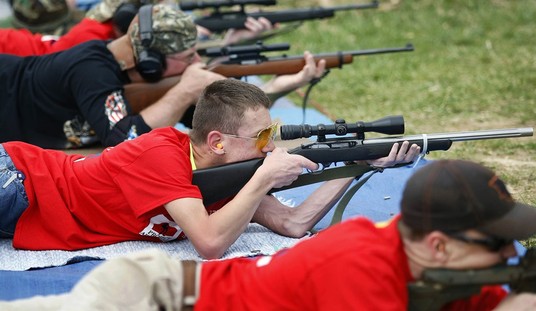
In a recent article on the Dick Metcalf controversy, a number of readers suggested that I might clarify my views on what restrictions on the Second Amendment were appropriate. And so I shall. This, the first of a two-part series, will focus on the law as it exists.
Let’s keep in mind that the Second Amendment is a fundamental right based on the natural, unalienable right to self-defense. Firearms are protected because they are the most common, usual, and effective weapons used to secure the right to self-defense. Therefore, the standard that is applied in judging whether a given restriction on that right is constitutional is “strict scrutiny.” The Cornell Legal Information Institute describes it thus:
Strict scrutiny is a form of judicial review that courts use to determine the constitutionality of certain laws. To pass strict scrutiny, the legislature must have passed the law to further a ‘compelling governmental interest,’ and must have narrowly tailored the law to achieve that interest. A famous quip asserts that strict scrutiny is ‘strict in name, but fatal in practice.’
For a court to apply strict scrutiny, the legislature must either have significantly abridged a fundamental right with the law’s enactment or have passed a law that involves a suspect classification. Suspect classifications have come to include race, national origin, religion, alienage, and poverty.
Cornell’s definition acknowledges that the devil is always in the details. While strict scrutiny might suggest that the government must clear very high barriers in order to infringe upon the Second Amendment, in practice, the hurdles might be knocked flat before the race begins.
We know that there is no such thing as an unrestricted right, and that in Heller (District of Columbia Et Al. v. Heller), the Supreme Court acknowledged this reality, while affirming that the right to keep and bear arms is a pre-existing, individual right:
Like most rights, the Second Amendment right is not unlimited. It is not a right to keep and carry any weapon whatsoever in any manner whatsoever and for whatever purpose: For example, concealed weapons prohibitions have been upheld under the Amendment or state analogues. The Court’s opinion should not be taken to cast doubt on longstanding prohibitions on the possession of firearms by felons and the mentally ill, or laws forbidding the carrying of firearms in sensitive places such as schools and government buildings or laws imposing conditions and qualifications on the commercial sale of arms.
What arms, then, are allowable? Heller directly suggests that “unusual and dangerous” arms may be restricted, and suggests, while not specifically saying, that fully automatic military-style weapons such as the M-16 (which it does specifically mention) may be restricted. However, the Court made clear that the government may not ban entire classes of the weapons commonly possessed and used for lawful purposes such as self defense, and uses handguns as a particular example of lawfully possessed arms:
Whatever the reason, handguns are the most popular weapon chosen by Americans for self-defense in the home, and a complete prohibition of their use is invalid.
Unfortunately, as is its usual practice, the Court did not deal with a great many of the issues relating to the Second Amendment:
JUSTICE BREYER chides us for leaving so many applications of the right to keep and bear arms in doubt, and for not providing extensive historical justification for those regulations of the right that we describes as permissible… But since this case represents this Court’s first in-depth examination of the Second amendment, one should not expect it to clarify the entire field…
The Heller decision seems to leave intact state laws regulating concealed carry, though recent court decisions have forced even Illinois—the last state with no concealed carry provision at all—to adopt, kicking and screaming and foot dragging, a concealed carry law. The direction of the law seems to be on the side of, at the very least, favoring concealed carry with common and usual restrictions, but not prohibiting it, and perhaps not overly restricting it. In other words, the momentum seems to be in favor of “shall issue,” rather than “may issue” concealed carry laws. After all, a CC law that gives local officials absolute discretion to allow or deny licenses is in effect a near absolute ban on concealed carry based on nothing more than the whims of party hacks and bureaucrats, and virtually certain to result in substantial abuse.
And while Heller suggests that entire classes of weapons used for lawful purposes may not be banned, it does not explicitly protect weapons like the AR-15 family, the most popular modern sporting rifles in America. Few common firearms are currently more demonized than the ubiquitous AR-15, however, since such weapons are nothing more than semi-automatic rifles–there is no such thing as an “assault weapon”–and since they are common and usual weapons often used for self-defense, the presumption of lawfulness is probably on their side.
Heller also directly suggests that the use of handguns in the home for self-defense enjoys the highest constitutional protection, but it does not explicitly extend that protection to carrying a weapon outside the home, concealed or otherwise, though its language is suggestive of this. In fact, Heller may be read to allow the banning of open carry of handguns.
Even so, the momentum and weight of lower court decisions–and arguably the logic of Heller–seems to be on the side of self-defense, concealed carry, and particularly carrying outside the home. A right to self-defense recognized only in the home or on one’s property is not a right at all. How can one’s right to preserve their very life vanish the moment they leave their property? Who can live a life restricted only to a single suburban acre or urban apartment? What of the rights of freedom of movement and association if one has no ability of self-defense?
Heller did not address accessories at all, but again, lower court decisions seem to suggest that bans on magazine capacity and other accessories may be invalid. New York’s hastily considered SAFE Act, for example, banned all magazines of greater than seven round capacity. This is likely to be overturned for several compelling reasons: It cannot pass strict scrutiny. Seven round magazines for common and usual handguns do not exist. The law outlawed the magazines carried by police officers, and if the police need standard sized magazines–the magazines designed for and supplied with common handguns–how can keeping them from citizens be justified?
In addition, there is no proof that magazine capacity limitations in any way discourage crime or enhance public safety. In fact, the Clinton Gun Ban, in effect for ten years, had a ten round magazine capacity ban, and it accomplished absolutely nothing but inconveniencing the law-abiding. It was also a political disaster for Democrats, and not only did they allow it to sunset when its decade-long run expired, they have been notoriously shy about supporting sweeping gun control proposals since. Bill Clinton admitted that the gun ban cost many Democrats their seats, and Al Gore’s support for gun control probably cost him the presidency.
The extraordinary growth of interest in firearms and gun ownership during the Obama years, fired by a growing and likely permanent distrust of government, is also a very encouraging sign for gun owners and the maintenance and potential expansion of the interpretation of the Second Amendment. The less advantage and the more political danger Democrats see in gun control legislation, the more likely it is they’ll not only leave it alone, but will tend not to meaningfully oppose efforts to establish incrementally greater liberty. Sheer numbers of gun-owning, freedom-appreciating citizens help in this, and an ever-growing NRA membership—more than a million new members since Mr. Obama took office—is also very helpful.
For the foreseeable future, most of the legal action on Second Amendment issues is likely to be centered around the states, which will continue to further illuminate the issues the Supreme Court did not touch in Heller. An example of this is the recent decision by Judge Edward Chang of the U.S. District Court for Northern Illinois who struck down Chicago’s absolute ban on retail sales of firearms. In a follow up decision, he gave Chicago 180 days to write an ordinance that comports with the Constitution.
While the current Supreme Court may seem to be friendly to the Second Amendment and willing to do their jobs based on the Constitution, precedence and the law rather than their own political whims, any such case heard before the court has the potential to cause great harm to liberty. The Supreme Court normally does not grant cert to any case unless it considers the issue to be “ripe,” which normally means that a number of lower courts have issued decisions on both sides of the issue, leaving the law decidedly unsettled in different parts of the country. For the moment, most Second Amendment decisions have been trending in the direction of greater freedom, so definitive decisions about concealed carry, bans on AR-15 type firearms, and related issues may very well take many years to materialize.
Remember that the states may not give their citizens fewer rights than the Constitution provides, but they may give them more rights. Citizens in Texas and California, for example, supposedly have Second Amendment rights, but it is difficult indeed for Californians—at least those not celebrities, the wealthy, or the politically connected—to exercise those rights in meaningful ways, such as by carrying a concealed weapon. This is not the case in Texas, though that state does have licensing fees and requirements far more burdensome than many might imagine of a plainly “red” state. Government relinquishes power in favor of individual liberty slowly and grudgingly everywhere.
Should the balance of the Supreme Court swing to the “living Constitution” wing, who prefer to judge based on pre-conceived progressive outcomes unavailable through the legislative process, it is unlikely that the Second Amendment would be entirely struck down. Even the progressive minority in Heller grudgingly admitted that the Second Amendment is an individual right. Given a chance, they would uphold the shell of the Second Amendment while simply stripping it of any application or effect in the real world. This would entail upholding virtually any and every restriction on the right imaginable while simultaneously claiming those restrictions consonant with the Second Amendment. Yes, that’s irrational, but no less true.
In Heller, for example, Justice Breyer advocated, rather than strict scrutiny, an “interest balancing inquiry,” which would allow the shell of the Second Amendment to stand while simultaneously upholding virtually any restriction. The majority wrote of that approach:
We know of no other enumerated constitutional right whose core protection has been subjected to a freestanding “interest-balancing” approach. The very enumeration of the right takes out of the hands of government—even the Third Branch of Government [the courts]—the power to decide on a case-by-case basis whether the right is really worth insisting upon. A constitutional guarantee subject to future judge’s assessments of its usefulness is no constitutional guarantee at all.
For a truly frightening look into the mind of a member of the progressive wing of the court—Justice Breyer—visit an article I wrote for PJ Media in 2010. Taking the link to the Heller decision and reading the tortured illogic of the minority dissent will be as instructive as it is alarming to anyone that loves liberty.
Those that would take liberty are in it for the long term, and they are infinitely patient. They believe the inevitable march of history is on their side, and if those that support the Constitution falter, or fail to pay attention, they’re right.
In the follow-up article, tentatively planned for next week, I’ll explore some enhancements to liberty that may be obtainable in the short and long term, and explain why some hopeful ideas must likely fall short.
Mike’s Home blog is Stately McDaniel Manor.








Join the conversation as a VIP Member